STS-76
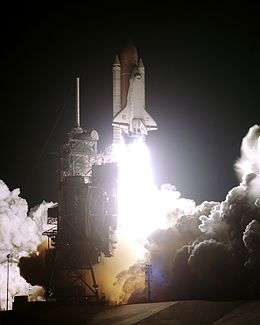 Space Shuttle Atlantis heads towards Earth orbit from Launch Complex 39B | |||||
| Mission type | Shuttle-Mir | ||||
|---|---|---|---|---|---|
| Operator | NASA | ||||
| COSPAR ID | 1996-018A | ||||
| SATCAT № | 23831 | ||||
| Mission duration | 9 days, 5 hours, 16 minutes, 48 seconds | ||||
| Distance travelled | 6,100,000 kilometres (3,800,000 mi) estimated | ||||
| Orbits completed | 145 | ||||
| Spacecraft properties | |||||
| Spacecraft | Space Shuttle Atlantis | ||||
| Launch mass | 111,740 kilograms (246,340 lb) | ||||
| Landing mass | 95,396 kilograms (210,312 lb) | ||||
| Payload mass | 6,753 kilograms (14,888 lb) | ||||
| Crew | |||||
| Crew size |
6 up 5 down | ||||
| Members |
Kevin P. Chilton Richard A. Searfoss Ronald M. Sega Michael R. Clifford Linda M. Godwin | ||||
| Launching | Shannon Lucid | ||||
| Start of mission | |||||
| Launch date | 22 March 1996, 08:13:04 UTC | ||||
| Launch site | Kennedy LC-39B | ||||
| End of mission | |||||
| Landing date | 31 March 1996, 13:28:57 UTC | ||||
| Landing site | Edwards Runway 22 | ||||
| Orbital parameters | |||||
| Reference system | Geocentric | ||||
| Regime | Low Earth | ||||
| Perigee | 389 kilometres (242 mi) | ||||
| Apogee | 411 kilometres (255 mi) | ||||
| Inclination | 51.6 degrees | ||||
| Period | 92.5 min | ||||
| Docking with Mir | |||||
| Docking port | SO starboard | ||||
| Docking date | 24 March 1996, 02:34:05 UTC | ||||
| Undocking date | 29 March 1996, 01:08:03 UTC | ||||
| Time docked | 4 days, 22 hours, 33 minutes, 58 seconds | ||||
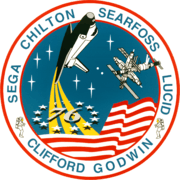 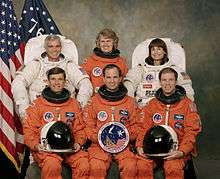 Left to right - Front: Sega, Chilton, Searfoss; Back: Clifford, Lucid, Godwin.
| |||||
STS-76 was NASA's 76th Space Shuttle mission, and the 16th mission for Atlantis. STS-76 launched on 22 March 1996 at 3:13 am EST (UTC −5) from Kennedy Space Center launch pad 39B. STS-76 lasted over 9 days, traveled about 3,800,000 miles (6,100,000 km) while orbiting Earth an estimated 145 times, and landing at 5:28 am PST (UTC −8) on 31 March 1996 at Edwards Air Force Base runway 22.
The flight was the third Shuttle mission to dock with the Russian Space Station Mir, as part of the Shuttle-Mir Program, carrying astronaut Shannon Lucid to the orbital laboratory to replace NASA astronaut Norm Thagard. STS-76 also carried a SPACEHAB single module along with Lucid, and on flight day 6 Linda Godwin and Michael R. Clifford performed the first U.S. spacewalk around two docked spacecraft.
Crew
| Position | Launching Astronaut | Landing Astronaut |
|---|---|---|
| Commander | Kevin P. Chilton Third spaceflight | |
| Pilot | Richard A. Searfoss Second spaceflight | |
| Mission Specialist 1 | Ronald M. Sega Second spaceflight | |
| Mission Specialist 2 | Michael R. Clifford Third spaceflight | |
| Mission Specialist 3 | Linda M. Godwin Third spaceflight | |
| Mission Specialist 4 | Shannon Lucid EO-21 Fifth spaceflight |
None |
Spacewalks
- Godwin and Clifford – EVA 1
- EVA 1 Start: 27 March 1996 – 06:34 UTC
- EVA 1 End: 27 – 12 March:36 UTC
- Duration: 6 hours, 02 minutes
Mission highlights
Third linkup between U.S. Space Shuttle and Russian Space Station Mir highlighted by transfer of veteran astronaut Shannon Lucid to Mir to become first American woman to live on station. Her approximately four-and-a-half month stay also eclipsed long-duration U.S. spaceflight record set by first American to live on Mir, Norm Thagard. Lucid was succeeded by astronaut John Blaha during STS-79 in August, giving her distinction of membership in four different flight crews—two U.S. and two Russian—and her stay on Mir kicked off continuous U.S. presence in space for the next two years.
Payload bay configuration included Orbiter Docking System in forward area and SPACEHAB single module toward the aft. STS-76 marked first flight of SPACEHAB pressurized module to support Shuttle-Mir dockings; single module primarily served as stowage area for large supply of equipment slated for transfer to space station, but also carried European Space Agency’s Biorack experiment rack for on-orbit research.
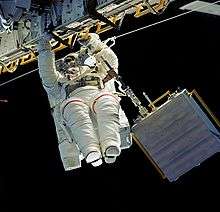
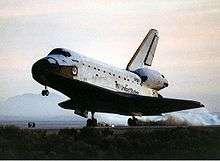
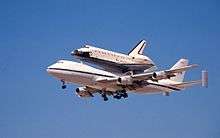
Atlantis hooked up with Mir on flight day three, following same R-bar approach employed on STS-74. Actual connection between Orbiter Docking System and Docking Module attached to Kristall module docking port occurred at 9:34 pm EST, 24 March. Hatches opened a little less than two hours later. Awaiting Atlantis' arrival were Mir 21 Commander Yuri Onufrienko and Flight Engineer Yuri Usachev, who were launched to Mir on 21 February. In July, they were joined by Mir 22 Commander Valeri Korzun, Flight Engineer Alexander Kaleri and CNES astronaut Claudie Andre-Deshays. After two-week stay, Andre-Deshays would return to Earth with Onufrienko and Usachev while Korzun and Kaleri remained on board with Lucid.
During five days of docked operations, about 1,500 pounds (680 kilograms) of water and two tons of scientific equipment, logistical material and resupply items transferred to Mir; experiment samples and miscellaneous equipment brought over to orbiter. In Biorack, 11 separate scientific investigations were conducted. Study topics included effect of microgravity and cosmic radiation on plants, tissues, cells, bacteria and insects and effects of microgravity on bone loss. Also transferred to station were Mir Glovebox Stowage (MGBX) equipment to replenish glovebox already on station; Queen’s University Experiment in Liquid Diffusion (QUELD) flown in orbiter middeck locker; and High Temperature Liquid Phase Sintering (LPS) experiment.
On flight day six, Godwin and Clifford conducted first U.S. extravehicular activity (EVA) around two mated spacecraft. During six-hour, two-minute, 28-second EVA, they attached four Mir Environmental Effects Payload (MEEP) experiments to station’s Docking Module. Experiments designed to characterize environment around Mir over an 18-month period. Godwin and Clifford wore Simplified Aid For EVA Rescue (SAFER) propulsive devices first flight-tested during STS-64.
Other payloads: Shuttle Amateur Radio Experiment (SAREX); KidSat, a project that gives middle school students opportunity to participate in space exploration; and Trapped Ions in Space (TRIS), a Naval Research Laboratory experiment flown in Get Away Special canister in cargo bay.
See also
- List of human spaceflights
- List of human spaceflights to Mir
- List of Space Shuttle missions
- Outline of space science
External links
![]() This article incorporates public domain material from websites or documents of the National Aeronautics and Space Administration.
This article incorporates public domain material from websites or documents of the National Aeronautics and Space Administration.

